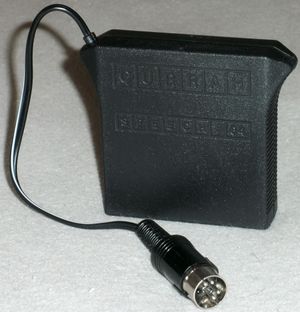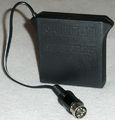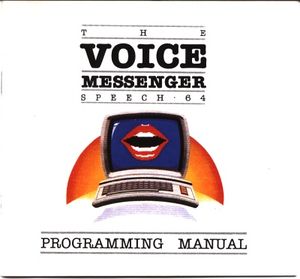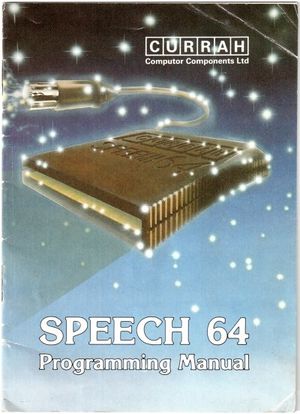Voice Messenger

|
This article is very short and not very detailed. Please help to improve it. |
| Voice Messenger | |
| Type: | Cartridge |
| Producer: | Currah Technology |
| Price: | 49.95 US$ |
| Released: | 1984 |
| Discontinued: | 199? |
| Processor: | |
| Memory: | |
| OS: | |
| Info: | Also available for ZX Spectrum |
The Voice Messenger or Speech 64 is a speech synthesizer cartridge for the Commodore 64.
The Voice Messenger cartridge was produced by Currah Technology in Boston, costing $49.95 in the USA. The cartridge contains a General Instruments SP0256-AL2 speech processor and dedicated memory, and therefore does not use the C64's memory. It can be used without any special software.
The Currah company was taken over by DK'Tronics on 1985, which continued to sell the cartridge.
Installation[edit | edit source]
The Speech 64 cartridge is plugged into the expansion port of the C64, with the power switched off. The audio plug can be plugged into speakers or devices which have a speaker plug in.
Manual[edit | edit source]
The manual is sized 14x14 cm and has 16 pages. It describes the handling of the cartridge in assembler and BASIC.
Table of content
- Setting up the Voice Messenger - Speech 64
- Simple words and phrases
- Using the allophones directly
- Using both voices and intonation
- The speech buffer
- Using machine code with the unit
Appendix I - Decimal and Hex Codes for the Allophones
Appendix II - An example program
Appendix III - A Description of the Extra Basic Commands for reference purposes
Programming[edit | edit source]
On activating the Speech 64 using the command INIT the following message is shown:
SPEECH 64 (C) CURRAH COMPUTOR COMPONENETS LTD.
Pressing a key activates a sound as speech. Entering the command KOFF switches off the keys sounds.
The command KON [0|1] toggles between lower and higher voice (default is voice 1).
The C64 speaks with the command SAY [0|1] "THE SPEAKING TEXT". For example:
SAY "I'M THE COMMODORE SIXTY FOUR"
To produce special or complex speech allophones must be used. For example: To make the computer say the word Hawaii the following is required as input:
SAY "[HAW(II)(EE)]"
Direct commands can be given for voice 0 or 1:
SAY 0 "HELLO" SAY 1 "GOOD BYE"
Single string variables can used, including arrays. The manipulation of strings osn't allowed from the SAY command. The limit of speaking text is 256 chars or allophones.
C$ = "[N(II)NT(EE)N]" SAY C$
The variable SP% shows the number of free characters (allophones) in the speech buffer, which also has a limit of 256 chars. The variable SP% is useful in avoiding a buffer overflow.
The command BYE switches off the Speech 64.
All commands can be used in a BASIC program.
Links[edit | edit source]
- More informations of Currah Speech
- More infos of Currah Speech at retrobrothers.hubpages.com
- ComTALKER 64 manual - Similair functions of the BASIC commands





